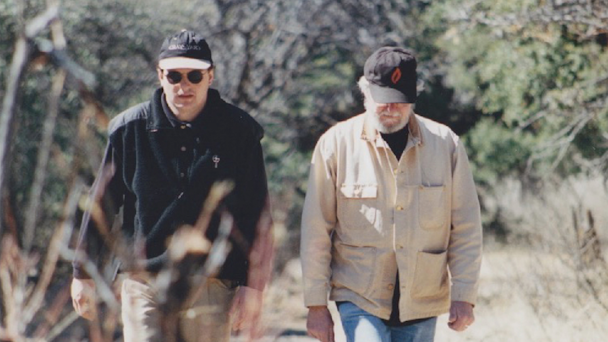With a population of 9.8m, America’s indigenous people ask: ‘Why don’t brands see us?’
‘Their needs are met by the government and they get free stuff already’ and ‘they speak English and already relate to us’ have long served as stubborn stereotypical barriers. Now Procter & Gamble and others have finally begun to recognize America’s indigenous people, as we find out as part of The Drum’s Marketing and the Marginalized Deep Dive.

Michael Gray and the late David Kennedy
The fact that American Indian/Alaska Natives (AI/AN) are an invisible minority is one stereotype that is actually true. However, US consumers have been raised on many others, whether it’s Land O‘Lakes packaging, mascots from professional sports teams or John Wayne disdainfully uttering: “You speak pretty good American for a Comanche.”
The reality is the 2020 US census uncovered that there are 9.79 million American Indian/Alaska Natives. The vast majority (78%) do not live on Reservations. More than half (57%) are married with kids and they are a young demographic with a media age of 29 (compared to the US population average of 37.2).
Yet this population has been largely ignored. “I’ve always struggled with why brands don’t see us,” says Michael Gray, president and executive creative director for G+G, an ad agency that specifically markets to the AI/AN population. Gray is also a member of the Blackfoot tribe.
But perhaps that’s about to change. Last month, Procter & Gamble added G+G to its preferred agency partner list. “It was a win just to be able to be in front of them and talk to them,” says Gray. He’s also seen other progress having joined the ANA’s Alliance for Inclusive and Multicultural Marketing, and having had the opportunity to speak to some of the other largest companies in the world.
He says they are constantly surprised by the number of AI/AN citizens. “When we reached 9.7 million, people were like, ‘who are you guys?’”
Another surprise was the fact that there are specific online, radio, print, outdoor and event channels in which to reach this audience. ‘They all live on Reservations with no media outlets’ is just one of the stereotypes Gray has been working to dispel. He made a lot of strong progress due to his own passion and hard work, as well as that of a powerful mentor.
‘You’re going to be working with this guy named David Kennedy’
Gray began his career in the marketing department at the Institute of American Indian Arts, which is a two-year federally-funded tribal school. The fact that it is only funded for two years is a key detail because this means there is a constant battle with the US Congress. In 1994, the fight for dollars was lost, and with it Gray’s job in the marketing department. However, Gray had been working with the American Indian College Fund and had been asked to do some design work with a board member named David Kennedy.
The beloved co-founder of Wieden+Kennedy, who passed away in October, became a pivotal mentor in Gray’s life. “He said to me, ‘Michael, I’ve heard of African-American shops, Asian, Hispanic. I’ve never heard of an American Indian ad agency. Just do it,” says Gray, referencing one of Kennedy’s most famous taglines. “You’re young enough and if anything goes wrong you can come work for us, but I don’t think it will.”
Aside from daily guidance, Kennedy helped the agency land its first federal work. He connected Gray with Joe Pytka, who has directed 14 ads for the agency. And he served as a lifelong friend and fighter for the American Indian community. Kennedy’s final work, ‘This is Indian Country,’ was created to promote the American Indian College Fund on Indigenous Peoples Day.
Gray, who moved to Portland recently, will miss the opportunity to work more closely with his mentor, but welcomes the challenge to keep pushing these important messages forward. “It was in my blood to get into the marketing field and really try and give us a voice,” says Gray. “It’s been a struggle, but it’s been a wonderful struggle.”
How brands should be speaking to American Indian/Alaska Native consumers
Matt Williams, Oglala Sioux Tribe, says:
I want brands and businesses to speak to me this way: I want to be spoken to in a way that doesn’t belittle our intelligence or assumes that we don’t know what’s best for ourselves and our communities.
I do not want to be spoken to in this way: I don’t want to be spoken to in a way that portrays messaging that is racist or upholds cultural stereotypes of Native people.
Zachary Gray, Little Shell Chippewa, says:
I want brands and business to speak to me this way: I am more than just a minority or cultural icon. I am an equal to my peers, I just happen to have deep cultural ties. I have opinions and ideas too as I have worked hard to be where I am at.
I do not want to be spoken to in this way: I don’t want to be talked down upon, just because I am different.
Paul Fragua, Jemez Pueblo says:
I want brands and business to speak to me this way: Speak to me as a person of value, like I matter. Value my voice, my perspectives, thoughts, and beauty. Value Natives as contemporary positive contributors to society... More inclusion. Includes us in all walks of life. Bring more visibility. If we are invisible, we are insignificant... Speak to the authentic and diversity of our beautiful people and don't relegate us all to a single plains culture imagery. Speak to me as a consumer of the products and brands advertised and marketed. Speak to me as a professional, successful business owner, a loving parent, grandparents, as an athlete. Speak to me as a family that enjoys going to Disneyland and vacations at nice resorts.
I do not want to be spoken to in this way: Do not speak to me as a relic of a romanticized past. Do not keep me in feathers and buckskin, or some corny outfit, and stoic. Do not call me chief or brave or squaw or Indian Princess. Do not speak to me as some sort of stereotype caricature or mascot. Don't appropriate our Native cultures and tell me you are honoring me.

